Contest Winning Stories
Matthew’s Stories on Other Sites
Read linked Sci Fi stories by Seth Comire and Matthew Cross about the prison system of the future.
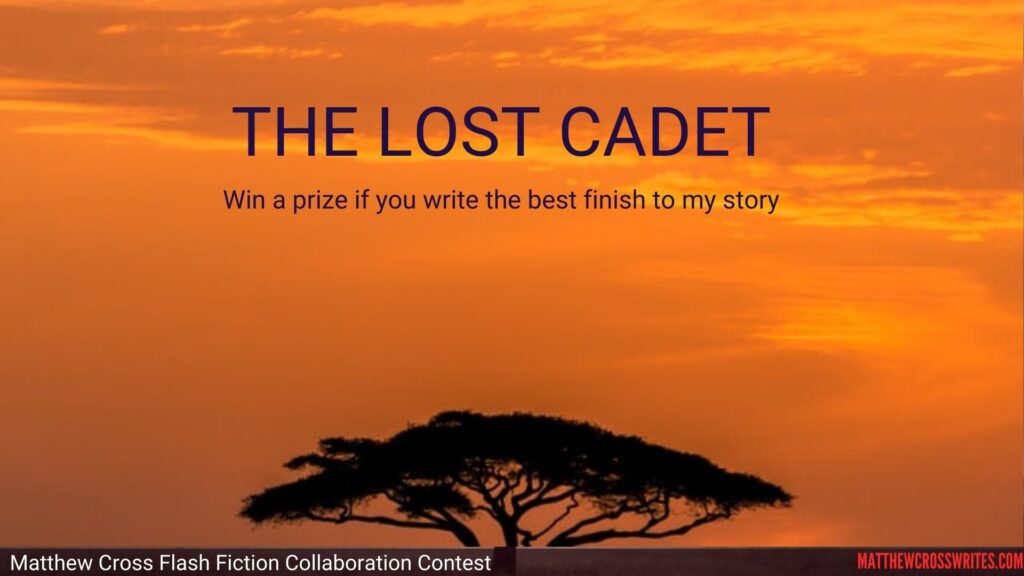
I loved Frasier Armitage’s ending to my flash fiction story, “The Lost Cadet.” It literally gave me goosebumps as I read it for the first time.
I was reading along, not even halfway through the finish, and I thought, “Yes, this is good! This story is worthy of being a winner!”
As I was setting up the page–I have to create a new blog post for the complete, winning story–I was in such a good mood. Was it because I love editing and fixing the space marks? No. I do enjoy editing, but not that much.
I took a seven-minute break–yes, I timed it–to unload the dishwasher. Because real life seeps in through the seams of our best fictional lives no matter how much we caulk them. I found myself singing “Let the Good Times Roll” by the Cars.
“Let the good times roll. Let good times ro-ooll! Let the GOOD … TIMES … ROLL!”
My grandmother, Eloise, used to say you can always tell a man is in a good mood when he’s whistling. I’ve found that to be true of men and women and equally true of whistling, singing or even just humming.
So, Frasier, thanks so much for giving a great ending to the January Contest story! Let the good times roll!
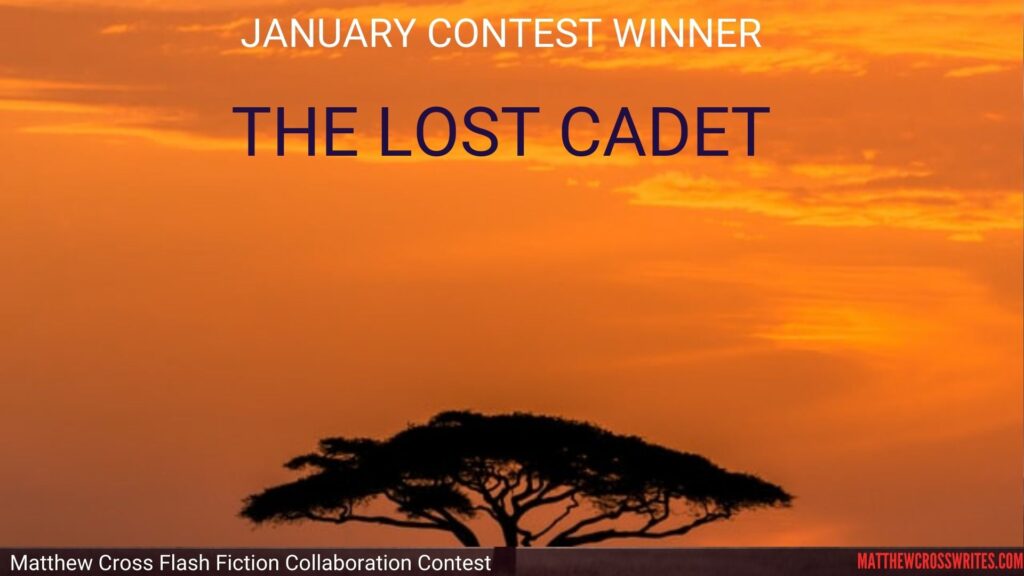
The winner of the Matthew Cross Flash Fiction Collaboration Contest is
February Contest: I’ll be announcing the February contest on Monday, Jan. 25.
I started the story below. See how Frasier seamlessly picks up the tale after the red line and gives us an exciting ending with a real twist. It blew me away!
by Frasier Armitage and Matthew Cross
Thrace smashed through the undergrowth as fast as she could. Every bush was twice her height and several times her width. Even the grasses on this planet grew as tall as an adult. And when she ran through the grass, the brilliant white sun shone in her face.
She could barely see where she was going and the grasstops whipped at her face and cut at her arms. But she did not care. She ran headlong from the beast that pursued her. When it bellowed, the vibrations ripped through her entire body. Her stomach turned to liquid, her knees lost their thrust, and even her molars ached. She tried covering her ears once, but that only protected her ears. And the beast had almost caught her!
She was living breath to ragged breath. Her lungs burned, her legs burned, her heart was trying to leap from her chest. She felt these things, but they were tiny details, drowned out by her sheer terror.
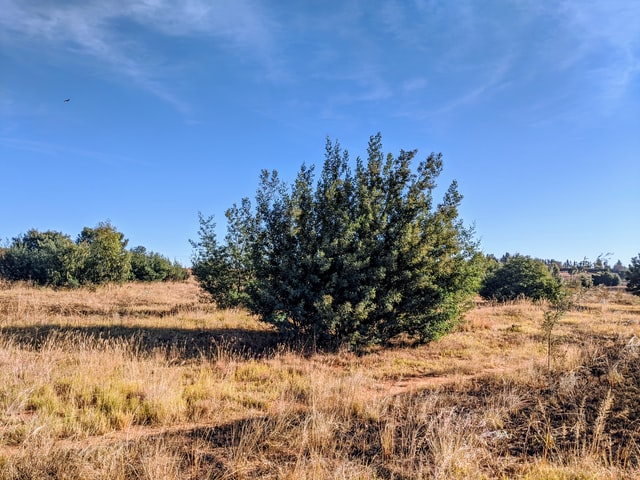
She ran towards the sun. She turned her head now and then, scanning for landmarks. Anything familiar. The landscape was a savanna. There were open spaces of grasses dotted with the giant bushes. Where the ground rose, there were trees. Trees as wide as a landing rocket and tall as a resi tower. On the hilltops, the trees grew in copses, but on the flats they grew singly.
The ground shook with the footfalls of the beast. The intelligent part of her brain–the part that was good at math and navigation–told her that made no sense. Even a creature eight-meters tall should not make the ground shake this far ahead of it. She had stopped screaming after the first fifty meters, but some part of her brain, the wild, animal part, still screamed louder than the intelligent part of her brain. Her burning lungs could barely keep the oxygen flowing, oxygen she needed to feed the muscles in her legs.
The ground shook with the footfalls of the beast.
She ran, following the sun. It was the only guide back to her hidey-hole. She had gone foraging for food. She had carefully noted her surroundings, even left poles of broken branches in the grassy places to guide her back. But she had gotten turned around.
She had blundered across the beast at a watering hole. The pond was wide and deep. The water almost clear. Thrace had dipped her canteen in the water, filled it and stood sealing the top. That’s when she noticed the water dripping eight meters from . . . from what? No tree branches were that low. From the bushes surrounding the pond? She looked across the pond, to her right, and saw it. A dark-blue reptile standing eight meters tall with slashes of dark brown and pale yellow giving it some camouflage. They both stood frozen while the last remaining gouts of water streamed from its mouth.
“Ahhhh . . .” Thrace said to no one.
The beast leaned forward and opened its mouth wide, letting out the first bellow. Thrace had fallen backwards from the force and covered her ears. Then she had been scrambling backwards on hands and feet. Somehow, she had risen to her feet and begun running. Running into the sun. She turned her head once and saw the beast leap.
It did not run around the pond or through it. It just leapt over the pond, landing where Thrace had stood!
Thrace had run straight across the open grassland, and the thing sprinted after her at an amazing speed. Thrace slid under the first bush she reached and crawled to the other side. The bush only slowed the beast a breath. If not for the one tree on a rise and the bushes surrounding it, the beast would have caught Thrace quickly.
“It’s a sprinter,” the intelligent part of her brain said.
On the open flats of the grassland, the beast could sprint at full speed on two giant legs. It could leap over lower bushes and tear its way through all but the densest undergrowth. Really, there was nowhere that it could not go.
That’s why Thrace had to find her hidey-hole. It was the only safe place.

Thrace had worked out a system of running along the higher ground, around the giant trees, all too tall and smooth to climb, and keeping bushes between her and the blue nightmare.
She learned its patterns. When it saw her, it bellowed and then charged at a sprint. The full force of that bellow reduced prey to quivering jelly. But the taller rises slowed its speed, and it could not turn easily. She avoided the open grasses and constantly changed course to avoid both the direct power of its bellow and its straight-line sprint.
Humans are apex predators. Humans can run long distances. Given enough time, ancient humans could run any prey to ground, no matter its size, strength or speed. Thrace knew these things. But those human hunters were adults in the prime of life with years of running experience. Thrace was a school kid who liked to shirk her turns at the shipboard cycles so she could read about theropods of the Cretaceous.
She changed direction again and her school bag lurched to the right and her canteen thumped hard against her thigh. The bag contained the food she had gathered–some mushroom-like fungi and a cluster of tiny, purple flowers–and the canteen held the only water she had had in days. She needed the food and water almost as much as she needed to escape her pursuer. She did not have the time to ditch either, and she needed them to survive.
That’s why Thrace had to find her hidey-hole. It was the only safe place.
Then she saw it. A broken branch on that tree off to the side. She recognized it! She recalled passing almost underneath that broken branch. She remembered thinking it would make a good landmark to guide her home. And she had been right.
She was close to her hidey-hole. No more than a five-minute walk.
The beast was crashing through a copse of bushes. It breathed hard and did not bellow. Was that because it could not see her yet or because it was winded? Not for the first time, she wished with all her being that the beast would tire and go away. Or that some other creature would wander across their winding path and distract the beast. Or that she had some camouflage, even some plain, brown clothing to blend into the brush. Her blue-and-yellow cadet uniform was as obvious as a supernova among the savanna’s shades of brown and tan.
The intelligent part of Thrace’s brain told her the color may not matter. The beast could be color blind. Or maybe it could see her in infrared. Or maybe it relied on sound and smell to find its prey. However it sensed her, she had tried standing still and silent, and it had not worked.
Thrace ran along the edge of a copse of bushes. She could make it now. She knew she could. And with this realization, her adrenaline seemed to flag, and she realized how truly tired she was. There, in the open, she saw a branch she had planted like a flagpole in the tall grass. She kept to the top of the slope, as high as the trees and brush allowed, and headed towards the hill ahead that she thought she recognized. Underneath that hillock was her hidey-hole and on the other side, in the wide grasslands, was the wreckage of the ship.

She ran left down the slope, not directly towards the hillock, and she heard the beast roar. She veered sharply to the right, before the rush of air and the strongest vibrations of that roar reached her. It began its charge down the slope and she could feel the thunder of its feet vibrating the ground even though she flew so fast it seemed her feet barely touched the ground. The sweaty hair on the nape of her neck stood on end. Her adrenaline was back, but it could not last long.
“I don’t belong here! I just want to go home!” she screamed with her mind. “Just leave me alone. Let me go! You don’t belong here either!”
Thrace leapt the hillock top and slid down the far side. The ground was littered with sunburnt leaves and they carried her nearly to the base of the hill. The beast was just on the other side of the hillock and the hill was not tall enough to curb its momentum. Still sliding, Thrace spun and scrabbled on hands and knees towards the hole dug into the base of the hill.
Teeth as long as Thrace’s arm jutted from a blood-red mouth.
The beast, a smooth-skinned reptile of blue, yellow and brown, exploded through the brush at the top of the hillock. Teeth as long as Thrace’s arm jutted from a blood-red mouth.
Thrace squirted into the hole and tumbled into the natural cavity she had spent days widening. She crabwalked backwards until her back hit the rough rock wall. She hugged her school bag and covered her face.
There was nothing else to do but wait. Wait and hope the beast was not good at digging.
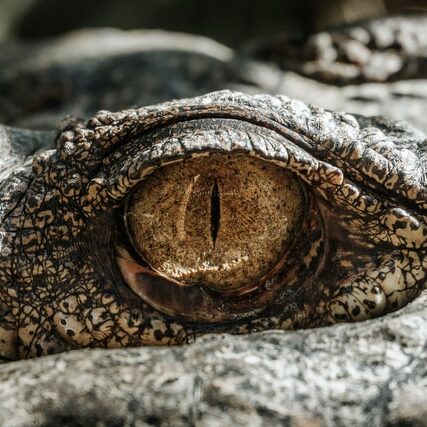
Thrace shook uncontrollably. Why had she dug the opening so wide? For more light? How stupid! Why had she not dug the tunnel deeper before widening the hidey-hole? Now, because she had wanted more light and space, she would die at the claws or teeth of this dinosaur-age monstrosity.
But she did not die. She shook silently and she listened. At first, the beast landed beyond the hillock and its thundering steps receded. Thrace cried silently, knowing it would return. And it did. It scratched and snuffed along the base of the hillock. She kept waiting for its yellow-slitted eye to appear at the end of the tunnel, but it never did. She heard heavy breathing and snuffling. Then a sort of bellowing snort, but not the full-strength bellow that preceded the beast’s sprinting charge.
Eventually, the too-heavy footsteps receded. Thrace broke down. A full-blown, shaking, crying, gibbering, snot-flying break down she had not had since she was very small. No, no, she had never had an episode this bad because she had never truly feared for her life before.
Eventually, she slept. Then she drank. Then she ate. When her meager supply was gone, she blew her nose, wiped her eyes, and cleaned herself up.

Finally, Thrace’s thinking brain reasserted itself. It was a brilliant brain. A brain so quick and sharp and crammed full of knowledge of the universe that she had been accepted as a cadet two years early. And her brain said a theropod did not belong on a planet with small, precise purple flowers or even a wide savanna. She could name ten planets that proved her point.
Maybe that was something she could work with. Maybe not.
Either way, she had work to do. She looked around her hidey-hole and catalogued the scant tools she had scavenged from the wreck. She nodded, a plan taking shape.
Thrace fixed a rag to her makeshift spear. She approached the entrance to her hidey-hole, gripping her knife, inclining her ear beyond the tunnel.
“Consider your surroundings,” she said to herself, repeating her training. “Consider your needs. Consider all things before you proceed.”
She inhaled deeply as the tall grass whispered beyond the cavern. A faint hiss crept closer. Then it stopped. A second passed. The hiss reappeared. The beast was out there. Waiting. Watching. Breathing.
Consider your surroundings. Check.

Her brain analyzed her plan. The knife should be enough, but she doused the rag in fuel, just in case. Grazes bit her knees from where she’d skidded into the cave, but she was ready.
Consider your needs. Check.
That beast doesn’t belong here, she thought. Nothing belongs here. This has to work.
Consider all things before you proceed. Check.
She drew breath, counting down from three … two … one. Thrace pounced into the open.
Thrace shrieked, her roar rivalling the creature’s own as its hulking frame blocked out the sun, casting her in shadow.
The beast’s roar bellowed as it thundered towards her. She struck her blade against the spear. Sparks erupted, setting the rag aflame.
Thrace shrieked, her roar rivalling the creature’s own as its hulking frame blocked out the sun, casting her in shadow. She dropped the rag and opened her arms, welcoming the beast’s jaws before the theropod exploded into a million pixels, along with the grass, the trees, and her hidey-hole.
Alarms shook the sim-suite. A tech removed Thrace’s helmet. Sanitized air filled her lungs.
Admiral Denvers loomed over her with the menace of that creature. “You lost, cadet. And you showed so much promise. Why give up?”
“I didn’t give up,” Thrace said, as nurses stripped her from the haptic suit.
“After all those weeks on the surface,” the Admiral continued, “and the care we took setting up this charade. You know how difficult it is to make a mind like yours believe it’s in another place? Just for you to quit when you got scared. It’s disappointing.”
“I did what you taught me, sir.”
Denvers scowled. “You failed.”
We’re never truly lost if we face our fears.
“No, sir. That beast—I’d seen it before, in a textbook on the Cretaceous period. I knew it didn’t belong there. Neither did I. How else could I explain why no other ships responded to my beacon? The simulation was obvious. So I ended it.”
“You knew?”
“‘Consider all things before you proceed.’ Right, sir?”
Denvers raised an eyebrow. “If you’re so smart, why would we go to all this effort if we wanted you to fail?”
Thrace thought for a moment. “This test isn’t about endurance. It’s about knowing what it’s like to be lost. Sometimes, when we feel lost, we’re in exactly the place we need to be.”
“Is that so?”
Thrace nodded. “We’re never truly lost if we face our fears. Being lost is just the first step towards being found.”
The Admiral smiled. He waved to the tech. “Terminate the Lost Cadet program,” he said. The alarms ceased. “Welcome home, Thrace.”
I hope you enjoyed this piece of flash fiction that Frasier and I wrote together. He’s such a great collaboration partner!
If you enjoyed Frasier’s prize-winning ending, please make sure and share some kind comments below.
Be stellar!
Matthew Cross
P.S. Here’s the inside scoop on how I chose Frasier’s ending as the winner.
P.P.S. Here’s another great ending written by Frasier Armitage:
To soldiers, information on the battlefield is essential. It’s the best defense and also a good weapon. That’s why soldiers of the future have all their information right at eye level.

Heads-Up Display–a presentation of information directly in the line of sight of a pilot or driver, often by projecting the information on a windshield, visor or other transparent screen.
The first HUDs were developed for military pilots so they would not have to look away from the horizon or an enemy combatant to read their gauges and other instruments. When you’re flying at 3,000 miles per hour, anything can happen in the flick of an eye.
Now carmakers use HUDs in passenger vehicles to show the driver everything from the vehicle’s speed to the radio station.
Let’s see where Sci Fi writers are placing HUDs.
In Behind Blue Eyes by Anna Mocikat, Nephilim belongs to the Guardian Angels of Olympias, an elite combat force of cyborgs. The Angels look like perfectly sculpted humans on the outside, except for their glowing neon eyes. Their limbs are entirely artificial and even their heads are filled with tech, including built-in HUD capabilities.
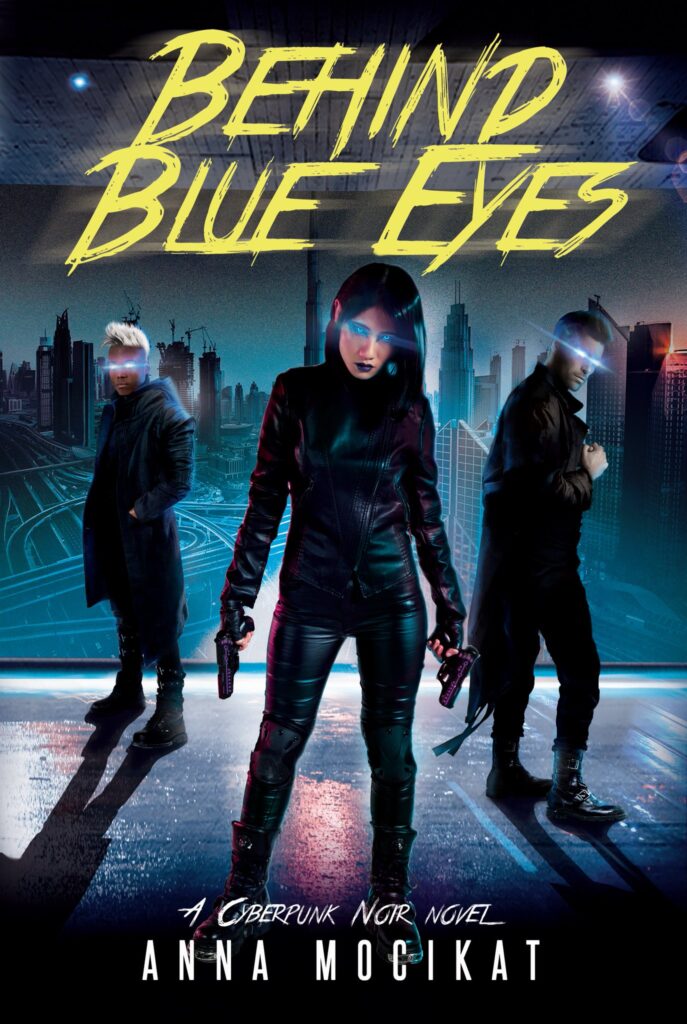
“Although the night was tenebrous, Nephilim saw the target location they were advancing on as perfectly as if it were bright daylight. Her artificial eyes were much more than integrated night vision gear. Special software connected to her brain made it possible to see everything clearly with a minimum amount of light, similar to how a cat’s eyes worked. Additionally, she activated a combat heads-up display, known as HUD that appeared directly in her line of sight, which would not only identify targets but prevent friendly fire.”
Now that’s a handy HUD. And for the Angels in Behind Blue Eyes, all their artificial upgrades are hidden inside, beneath the skin, except for their neon blue eyes.
The photographers of Unsplash.com provided me with a great collection of photos for my pass-the-baton December story: “Circle of Champions“
[Warning: This post contains spoilers. I recommend you read the story first and then enjoy the art below in its full glory.]
Let’s start with the main image for story. The only alterations I made to this photo were to crop it to fit and add the text. Here is the original, unaltered photo in all its glory.
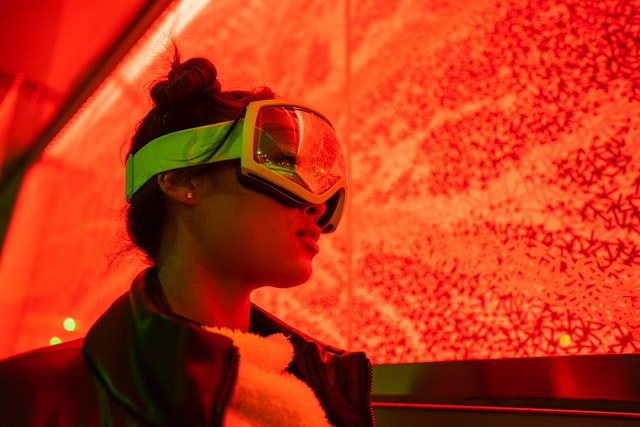
Actually, this photo was untitled, so I gave it the above descriptive title.
Kyle Johnson hails from Seattle, where he shoots mostly on film with a Nikon F3, an Olympus Stylus, and a Sony A7iii. He enjoys shooting outdoor and urban subjects.